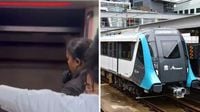In a startling incident during Wednesday morning's rush hour, a Sydney Metro train operated with its doors wide open, leaving passengers clinging to handrails as the driverless vehicle sped through a concrete tunnel. The train was traveling between Chatswood and Crows Nest stations, reaching speeds of up to 100 kilometers per hour when the door malfunction occurred.
The alarm was raised shortly after 8 am on April 2, 2025, when commuters noticed that the door remained ajar despite a digital sign above it reading, "this door is out of service." Video footage captured by passengers shows two staff members in black uniforms standing near the open door, attempting to manage the situation while communicating via walkie-talkies.
Ben McKimm, a passenger on the train, confirmed to Yahoo News that the train "just took off as they were trying to fix it." As the train sped along, passengers could be seen gripping the handrails tightly, their hair blowing in the wind created by the moving train.
Daniel Williams, CEO of Metro Trains Sydney, explained in a statement that the door fault was identified at approximately 8:01 am. "There was a Customer Journey Coordinator (CJC) and Customer Operations Lead (COL) on board the service," he said. "They were contacted by our Operational Control Centre and tried to remotely fix the issue. When this was unsuccessful, the OCC instructed the frontline staff to manually close the door." The two staff members were positioned at the door to ensure the safety of passengers until the train could safely reach the next station.
Once the train arrived at the next station, the door was closed, and the metro was taken out of service. Williams apologized for the distress caused to passengers, stating, "We apologise to customers for the concern this caused." The incident is currently under investigation by Sydney Metro.
This alarming event comes at a time when the Sydney Metro network is already under scrutiny due to ongoing expansion efforts that have led to significant disruptions for commuters. The T3 Bankstown train line will remain closed for longer than the initially proposed 12-month period, while the T6 line is set for an unscheduled closure lasting 63 days. As a result, up to 60,000 commuters are now relying on replacement bus services to navigate the city.
"We apologise for the inconvenience this may cause, but the disruption is required to complete the rigorous testing to prepare for first passenger services," Sydney Metro stated, highlighting the challenges faced as they expand the network.
The Sydney Metro, which first opened in May 2019, has since expanded its services, connecting various locations between Chatswood and Rouse Hill's Tallawong station in the city's north. The network has seen new stations opened in August, linking the existing line to additional locations before ending in Sydenham. However, the continued expansion has been fraught with commuter delays and train station closures, making it increasingly frustrating for Sydneysiders trying to get around during peak hours.
Despite these challenges, the new metro line has been a significant investment, with a total cost of $25 billion. It was designed to improve public transport efficiency in Sydney, but incidents like the one on Wednesday raise questions about safety and operational reliability.
As the investigation into the door malfunction continues, commuters are left wondering about the implications for their daily travel and the overall safety of the metro service. The incident has sparked discussions on social media, with many expressing their shock and concern over the safety measures in place for such a high-speed transit system.
In addition to the immediate concerns regarding passenger safety, there are broader implications for Sydney Metro's reputation. With the system still relatively new, first impressions are crucial, and incidents like this can significantly impact public confidence.
Commuters are advised to stay informed about the ongoing investigation and any updates regarding service disruptions. As the situation develops, it will be essential for Sydney Metro to address not only the technical failures that led to this incident but also the communication and crisis management protocols in place to ensure passenger safety in the future.
As the city continues to grow, the demand for efficient and safe public transportation will only increase. It remains to be seen how Sydney Metro will respond to this incident and what measures will be implemented to prevent similar occurrences in the future.
For now, the focus is on ensuring that all aspects of the metro service are functioning correctly and that passengers can travel with confidence.









